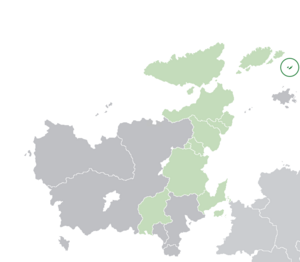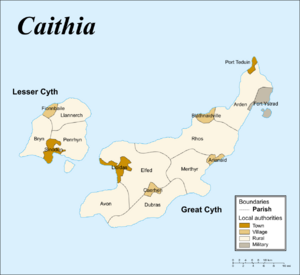Caithia
Mormaerdom of Caithia | |
|---|---|
Motto: "Ein Ynysoedd, Diogelu" "Our Islands, Defend" | |
 | |
 | |
| Capital and largest settlement | Lloidas |
| Official languages | Ghaillish Caithian |
| Ethnic groups | 74% Caithian 22% Ghaillish 5% other |
| Religion | Church in Caithia |
| Demonym(s) | Caithian |
| Government | Devolved government within a parliamentary constitutional monarchy |
• Mormaer | Kenneth IV |
• Governor | Órla Ní Fhlannagáin |
| Duane ap Drummond | |
| Legislature | Cynulliad |
| Autonomy within the Kingdom of Glytter | |
• First Tenic settlement | 200s BCE |
• Arrival of the Verique | 1200s CE |
• Autonomy granted | 11 June 1978 |
| Area | |
• Total | 490.44 km2 (189.36 sq mi) |
| Population | |
• 2018 estimate | 46,128 |
| GDP (PPP) | 2017 estimate |
• Total | $0.9 billion |
• Per capita | $20,192 |
| Currency | Euclo (EUC (€)) |
| Time zone | Euclean Standard Time |
| Date format | dd-mm-yy |
| Driving side | right |
| Calling code | +66 |
| Internet TLD | .gl |
Caithia (Caithian: Ynys Cyth, Ghaillish: Cait), officially the Mormaerdom of Caithia (Caithian: Tir Ynys Cyth, Ghaillish: Mormaerdha na Cait) is an autonomous county within the Kingdom of Glytter, located in northern Euclea. The islands host 46,128 residents, the majority of whom are Caithian. Ghaillish and the native Caithian hold the status of co-official languages on the islands.
Evidence of human activity on the islands dates back to the 7000s BCE, with Tenic influence beginning in the 200s BCE. The Caithians diverged from the Ghailles, becoming the sole members of the Caithian branch of Insular Tenic. The islands were feared by ancient Euclean navigators, known for their screaming woad-wearing tribesmen. Starting in the 1200s CE, the Verique who had established themselves as the lords of Glytter sent expeditions to claim the islands for the Crown. It was subsumed into the Ghaillish realm, and operated largely as a normal lordship.
In 1678, the Verique dynasty of the islands died out, and Queen Fiona VII came into possession of the islands, turning it into royal domain. A summer-and-lake-house was constructed on the islands as an additional royal residence. Throughout the late 1800s, as nationalism arose across Euclea, a Caithian national identity emerged. In 1978, after pro-independence protests erupted across the island, Caithia was granted limited autonomy from the Ghaillish Crown in the Caithian Home Rule Bill. The level of autonomy experienced by Caithia has been gradually increasing over the years, but a stark divide exists between unionist and separatist factions on the islands.
The fishing and oil industries are major employers on the islands, together providing 21% of GNP, while the Ghaillish Ministry of Defence contributes a further 11%. Caithia exists under the same administration as Glytter, and is considered an autonomous county. The head of state is Mormaer Kenneth IV, represented by Governor Órla Ní Fhlannagáin, while Chief Minister Duane ap Drummond acts as the head of government, commanding a majority in the Cynulliad.
History
Early and pre-Ghaillish history
Arrival of the Verique and Glytteronian Caithia
Modern history and devolution
Geography
Climate
Fauna and flora
Politics and government
Following the introduction of home rule through devolution, the Caithian government has gained limited executive power over local affairs. Kenneth IV, King of Glytter, acts as head of state through his role as the Mormaer of Caithia. In the islands themselves, he is represented by Órla Ní Fhlannagáin, the Governor of Caithia. The role of head of government and most executive power resides with the Chief Minister, who alongside the 32-member Cynulliad can exercise limited legislative power.
Political parties
| Logo | Party | Leader | Seats in the Cynulliad | Ideology | Affiliation | ||
|---|---|---|---|---|---|---|---|

|
Forward Ymlaen Ar Aghaidh |

|
Duane ap Drummond | 9 / 32
|
Social democracy Caithian autonomy |
||
| Homeland Mamwlad Baile Dúchais |

|
Eirwyn ap Gwyn | 7 / 32
|
Democratic socialism Left nationalism Caithian separatism |
|||

|
Trawlers' Interest Diddordeb Dreillong Ús Trawlaí |

|
Ieuan ap Dafyd | 6 / 32
|
Centrism Agrarianism Glytteronian unionism |
Centre | |

|
Social Democrats in Caithia Democratiaid Cymdeithasol Daonlathaithe Sóisialta |

|
Aoife Nic Dhiarmaid | 4 / 32
|
Social democracy Glytteronian unionism |
Social Democrats | |

|
Liberty and Justice Rhyddid a Chyfiawnder Saoirse agus Ceartas |

|
Carwyn ap Gruffudd | 4 / 32
|
Libertarianism Glytteronian unionism |
Liberty | |

|
Caithian Pride Balchder Cyth Bród na Cait |

|
Meredudd ap Pennant | 1 / 32
|
Conservatism Caithian ethno-nationalism Caithian separatism |
||
| 26 Movement 26 Symudiad 26 Gluaiseacht |

|
Mícheál Ó Faoláin | 1 / 32
|
Conservatism Glytteronian unionism |
National Party | ||
Administrative divisions
Caithia is comprised of two main inhabited islands and a number of smaller islets, which have no legal recognition. They are officially divided into 16 parishes (Caithian: plwyf; Ghaillish: paróiste). Parishes are defined as either town, village or rural parishes, though the distinction is solely in name. Despite their existence, the parishes exercise and experience few legal rights or responsibilities, and are primarily utilised for census-taking and electoral purposes. The parish is the only level of recognized administrative division in Caithia.
| Island | Type | Parish | Area km2 | Population |
|---|---|---|---|---|
| Great Cyth | Town | Lloidas | 9.10 | tbd |
| Town | Port Teduin | 2.45 | tbd | |
| Village | Caerhen | 4.16 | tbd | |
| Village | Arianaid | 3.42 | tbd | |
| Village | Bláthnaidville | 9.30 | tbd | |
| Rural | Dubras | 50.19 | tbd | |
| Rural | Elfed | 77.69 | tbd | |
| Rural | Avon | 42.71 | tbd | |
| Rural | Arden | 59.98 | tbd | |
| Rural | Merthyr | 46.52 | tbd | |
| Rural | Rhos | 78.72 | tbd | |
| Lesser Cyth | Town | Sinodun | 7.97 | tbd |
| Village | Fionnbaile | 4.45 | tbd | |
| Rural | Bryn | 27.15 | tbd | |
| Rural | Llannerch | 28.13 | tbd | |
| Rural | Penrhyn | 38.50 | tbd |




